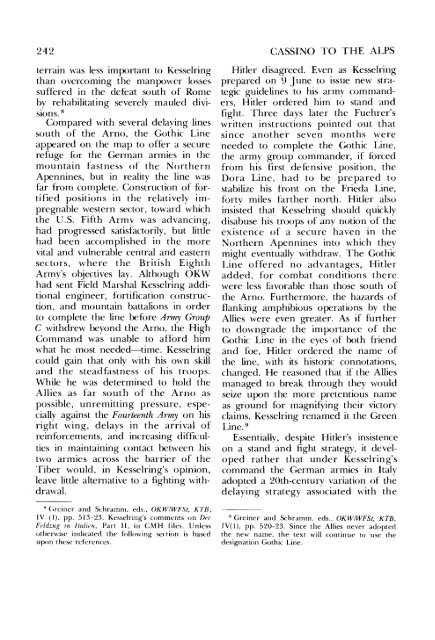Cassino to the Alps - US Army Center Of Military History
Cassino to the Alps - US Army Center Of Military History
Cassino to the Alps - US Army Center Of Military History
You also want an ePaper? Increase the reach of your titles
YUMPU automatically turns print PDFs into web optimized ePapers that Google loves.
242<br />
terrain was less important <strong>to</strong> Kesselring<br />
than overcoming <strong>the</strong> manpower losses<br />
suffered in <strong>the</strong> defeat south of Rome<br />
by rehabilitating severely mauled divisions.<br />
8<br />
Compared with several delaying lines<br />
south of <strong>the</strong> Arno, <strong>the</strong> Gothic Line<br />
appeared on <strong>the</strong> map <strong>to</strong> offer a secure<br />
refuge for <strong>the</strong> German armies in <strong>the</strong><br />
mountain fastness of <strong>the</strong> Nor<strong>the</strong>rn<br />
Apennines, but in reality <strong>the</strong> line was<br />
far from complete. Construction of fortified<br />
positions in <strong>the</strong> relatively impregnable<br />
western sec<strong>to</strong>r, <strong>to</strong>ward which<br />
<strong>the</strong> U.S. Fifth <strong>Army</strong> was advancing,<br />
had progressed satisfac<strong>to</strong>rily, but little<br />
had been accomplished in <strong>the</strong> more<br />
vital and vulnerable central and eastern<br />
sec<strong>to</strong>rs, where <strong>the</strong> British Eighth<br />
<strong>Army</strong>'s objectives lay. Although OKW<br />
had sent Field Marshal Kesselring additional<br />
engineer, fortification construction,<br />
and mountain battalions in order<br />
<strong>to</strong> complete <strong>the</strong> line before <strong>Army</strong> Group<br />
C withdrew beyond <strong>the</strong> Arno, <strong>the</strong> High<br />
Command "vas unable <strong>to</strong> afford him<br />
what he most needed-time. Kesselring<br />
could gain that only with his own skill<br />
and <strong>the</strong> steadfastness of his troops.<br />
While he was determined <strong>to</strong> hold <strong>the</strong><br />
Allies as far south of <strong>the</strong> Arno as<br />
possible, unremitting pressure, especially<br />
against <strong>the</strong> Fourteenth <strong>Army</strong> on his<br />
right wing, delays in <strong>the</strong> arrival of<br />
reinforcements, and increasing difficulties<br />
in maintaining contact between his<br />
two armies across <strong>the</strong> barrier of <strong>the</strong><br />
Tiber would, in Kesselring's opinion,<br />
leave little alternative <strong>to</strong> a fighting withdrawal.<br />
"Greiner and &:hramm, cds., OKWIWFSt, K7B,<br />
IV (I), pp, 513·,23, Kesselring's comments on Dn<br />
Fl'idwg In Italim, Part II, in CMH files. Unless<br />
o<strong>the</strong>rwi;;e indicated <strong>the</strong> following section is based<br />
upon <strong>the</strong>se references,<br />
CASSINO TO THE ALPS<br />
Hitler disagreed. Even as Kesselring<br />
prepared on 9 June <strong>to</strong> issue new strategic<br />
guidelines <strong>to</strong> his army commanders,<br />
Hitler ordered him <strong>to</strong> stand and<br />
fight. Three days later <strong>the</strong> Fuehrer's<br />
written instructions pointed out that<br />
since ano<strong>the</strong>r seven months were<br />
needed <strong>to</strong> complete <strong>the</strong> Gothic Line,<br />
<strong>the</strong> army group commander, if forced<br />
fn:>m his first defensive position, <strong>the</strong><br />
Dora Line, had <strong>to</strong> be prepared <strong>to</strong><br />
stabilize his front on <strong>the</strong> Frieda Line,<br />
forty miles far<strong>the</strong>r north, Hitler also<br />
insisted that Kesselring should quickly<br />
disabuse his troops of any notion of <strong>the</strong><br />
existence of a secure haven in <strong>the</strong><br />
Nor<strong>the</strong>rn Apennines in<strong>to</strong> which <strong>the</strong>y<br />
might eventually withdraw. The Gothic<br />
Line offered no advantages, Hitler<br />
added, for combat conditions <strong>the</strong>re<br />
were less favorable than those south of<br />
<strong>the</strong> Arno. Fur<strong>the</strong>rmore, <strong>the</strong> hazards of<br />
flanking amphibious operations by <strong>the</strong><br />
Allies were even greater. As if fur<strong>the</strong>r<br />
<strong>to</strong> downgrade <strong>the</strong> importance of <strong>the</strong><br />
Gothic Line in <strong>the</strong> eyes' of both friend<br />
and foe, Hitler ordered <strong>the</strong> name of<br />
<strong>the</strong> line, with its his<strong>to</strong>ric connotations,<br />
changed. He reasoned that if <strong>the</strong> Allies<br />
managed <strong>to</strong> break through <strong>the</strong>y ,,,,'ould<br />
seize upon <strong>the</strong> more pretentious name<br />
as ground for magnifying <strong>the</strong>ir vic<strong>to</strong>ry<br />
claims. Kesselring renamed it <strong>the</strong> Green<br />
Line. 9<br />
Essentially, despite Hitler's insistence<br />
on a stand and fight strategy, it developed<br />
ra<strong>the</strong>r that under Kesselring's<br />
command <strong>the</strong> German armies in Italy<br />
adopted a 20th-century variation of <strong>the</strong><br />
delaying strategy associated with <strong>the</strong><br />
"Greiner and Schramm, eds" OKW/WFSt, KTB,<br />
IV(l), pp. 520-23, Since <strong>the</strong> Allies never adopted<br />
<strong>the</strong> new name, <strong>the</strong> text will continue <strong>to</strong> use <strong>the</strong><br />
designation Gothic Line,
















